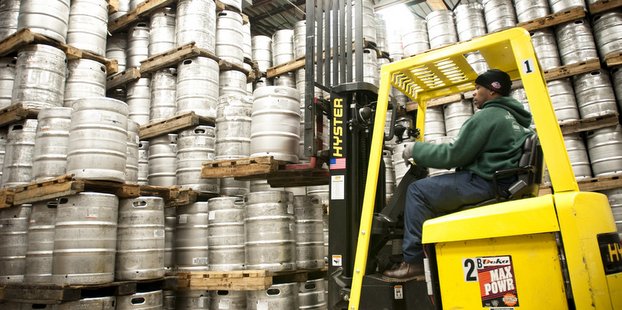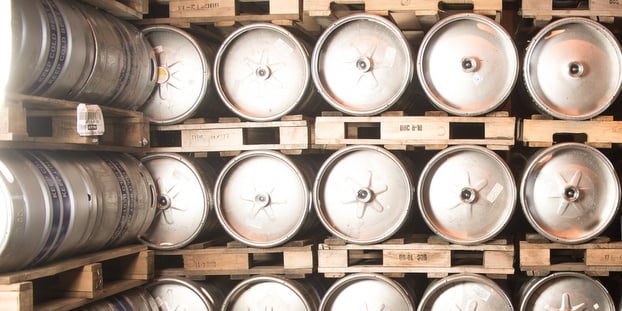
After a long day of writing about craft beer, the Craft Brewing Business crew walked over to one of its favorite Happy Hour bars to start drinking some craft beer. I surveyed the taps and noticed one that really stood out – it looked like a can actually. I asked what it was – it was the Gubna from Oskar Blues, an Imperial IPA. I was not in the mood for a 10-percenter, but I was already too interested to turn back. I ordered it, and it was just outstanding. Who knows what I would have ordered if that tap handle didn’t stand out. Thanks, tap handle!
For some brewers, the tap handle becomes their calling card. For others, the tap handle is a traveling sales man. An intriguing, unique, descriptive or clever tap handle could mean a couple more pulls a week, which when spread out over the year, and in each of your locations, could be the spring board that changes the scope of your brewery or allows you to hit the numbers you hoped. Conversely, that dull, nondescript or unattractive handle could send your numbers in the other direction.
Let’s do a quick dive into the ins and outs of tap handle ordering and cover a couple trends that are out there in the market right now, competing with your tiny traveling sales team.
I’m ready to ship some beer, how long is this going to take?
Whoa, whoa, whoa – hold on there, guys and gals. Ordering a set of tap handles can take a bit of time, especially if you are looking to fancy it up. Take Alexander Global Promotions (AGP), for example, which specializes in three-dimensional handles. Malcolm Alexander, president of AGP, lays it out like this:
“A picture can say 1,000 words, and 3-D designs can communicate at a greater multiple than a decal. Keep the ‘craft’ top of mind – show innovation and not conformity.” — Malcolm Alexander, Global Alexander PromotionsAlexander assigns a design team to work with you, and then you have to work through that process – either by giving exact details of what you are looking for by workshopping some concepts out with the team (that’s what they are there for, after all). After that idea is tweaked and OK’d, a 3-D Mud Mold is created. Once that Mud Mold is created and approved, the team provides a final painted sample. After approval of THAT sample, production starts.
“There is a stage where we communicate regularly and adjust the mold to meet your needs,” he said. “Three-D work requires the contact and feedback to generate the piece you want. There is no canned solution – it is all creative design.”
[satellite gallery=9 auto=off caption=off thumbs=on]
All told, Alexander says to provide 110 to 120 days from the start of the process until delivery to the brewery. AGP typically works with medium to larger scale brewers and generally starts orders at the 200 tap handle mark on up to 5,000-plus per order.
Andy Bauer, national sales for AJS Tap Handles reported a similar timeline, saying the production run itself can take anywhere from six to eight weeks, and a lot of that varies depending on the complexity of the order. That order complexity also changes the minimum order quantity at AJS, which ranges from 20 to 100, depending on the customization of the final design.
What do we mean by complex? What are my options here?
Tap handle suppliers all differ in the materials they use, and you’ll want to take all of those decisions into consideration when creating the overall look and message of your final product. AJS, for example, primarily uses wood, urethane and metal but does allow for the use of other materials if necessary, like using acrylic parts for shields and top caps. Bauer breaks them down:
Wood is versatile and can be used for a lot of different applications (handles, signs, taster trays, chalkboards). Cost is usually a little lower; it is lighter weight. If stained then the beauty of the wood stands out. Limitations would be a very ornate design or a figural piece. You also can have issues if the end-user does not maintain properly.
Urethane is great for very detailed pieces that can be done with a mold, especially figural pieces or something that cannot be turned from wood. Strength is a positive of the overall material that can last a very long time. Limitations can be the cost, and if the piece has small thin pieces sticking out, there can be breakage when mishandling.
Metal is a very appealing right now because people love the industrial look. Strength of the material is a positive as well as the magnetic property which customers like so they can use an interchangeable magnetic decal. Limitations are usually the weight and sometimes cost depending on the design.
Because it specializes in 3-D molds, AGP sticks with poly stone, which Alexander says is malleable in design and is able to provide great detail in 3-D – including the look of wood grain or texture. The handles are up to 14 in. and will generally be less than 1 lb in weight.
Hmm, lots to think about there. Any other pricing details?
Bauer said the cost structure is usually based on three things:
- The quantity of the handles. The larger the order, the higher the price breaks will be.
- The design. “If you use our stock shapes or a very basic design the price will be lower. If you go completely custom and very elaborate the price will climb quickly.”
- Any additional decaling, such as magnetic decals or printing or laser engraving.
Bauer said basic handles can go for around $10 to $15 where an extremely customized handle can go run $25-plus. The usual range can be from around $17 to $22, but it’s all relative to design and quantity.
Alexander said AGP provides a cost structure of $8.99 per 9-in. handle with $1 added for each extra inch of height. All of the creative help at the front-end of the process carries no additional cost.
Alright, meeting with my creative team – any tips or trends to keep in mind?
Bauer said to keep these four things in mind:
- Think of what you want your handle concept to be. What we should center the design around?
- How many sides do you want the handle to be (2,3 or 4)?
- Will it be a specific handle to one beer or should it be an interchangeable handle?
- How do you want to display your logo or what should be on the handle?
“We have also seen a spike in people looking for metal handles or handles that look like metal,” Bauer said. “The industrial look seems like a trend right now.”
The interchangeable areas are becoming more popular because craft brewers can more easily adapt their current stock of handles to meet their ever-changing rotation and varieties without having to go through an entire new tap handle ordering process. Similarly, Alexander says to keep durability in mind when in the design process, but most importantly, focus on an image that is simple and eye-catching.
“A picture can say 1,000 words, and 3-D designs can communicate at a greater multiple than a decal,” he said, “Keep the ‘craft’ top of mind – show innovation and not conformity.”
Wrap this all up for me
Think back on my personal tale in the lead. Science, creativity and market know-how went into that handle and, in turn, drove my decision to buy a product of which I had no prior knowledge. That’s one small anecdote of a curious and satisfied customer, but it’s a universal story that repeats every day across the country. The value of the tap handle is built by these seemingly arbitrary transactions over its lifetime. Add all of them up and the final tally looks a little less arbitrary. Be sure your tap handle decision-making isn’t either.
Tap handle vendors:
| AJS Tap Handles |
| Alexander Global Promotions |
| Alison Group, The |
| Boelter Beverage |
| Chrislan Ceramics Inc |
| Last Call Production, LLC |
| Mark Supik & Company |
| Sculpture Concepts |
| Taphandles, LLC |





Jason Roberson says
Something important to consider is the Creative Ownership of your custom Taphandle design. In many cases, the taphandle supplier will own the (IP) rights to your new handle design and can charge you a royalty to use the design, or require you to order the design thru them exclusively.
Sierra Nevada, Mad River and several of my other clients collaborated with me to design their new taphandles in order to retain 100% exclusive ownership of the design. By owning the rights to the design they are able to shop around the designs to all of the taphandle vendors above. You’ll get the best pricing this way and will retain ownership of the design forever.
Jason Roberson (www.CraftBeerBranding.com)
RT @CraftBrewingBiz: Tap handles 101: http://t.co/pFU6KKA20Z Consider the timeline, design trends #Sundayreading
RT @CraftBrewingBiz: Tap handles 101: http://t.co/pFU6KKA20Z Consider the timeline, design trends #Sundayreading
RT @CraftBrewingBiz: Tap handles 101: http://t.co/pFU6KKA20Z Consider the timeline, design trends #Sundayreading
Jamie says
Nice article. Point of sale in craft brewing industry has really become very important as breweries try to create their own brand identity.
#CraftHarlem Tap handles 101: Consider the timeline, design trends – Craft Brewing Business http://t.co/DzbQGc5uEo